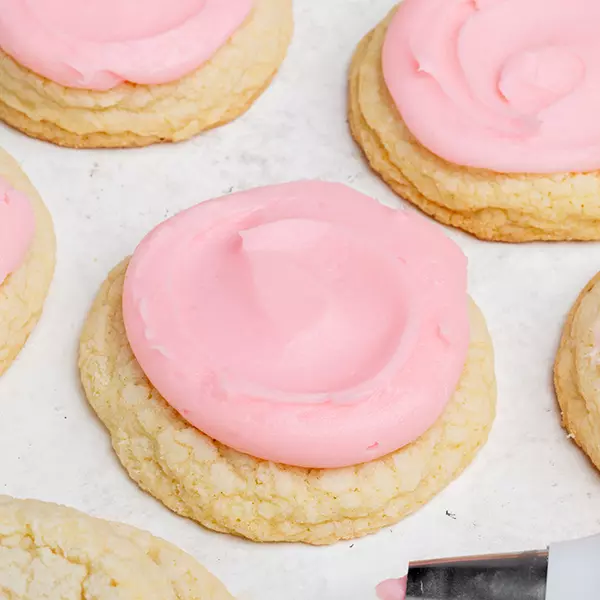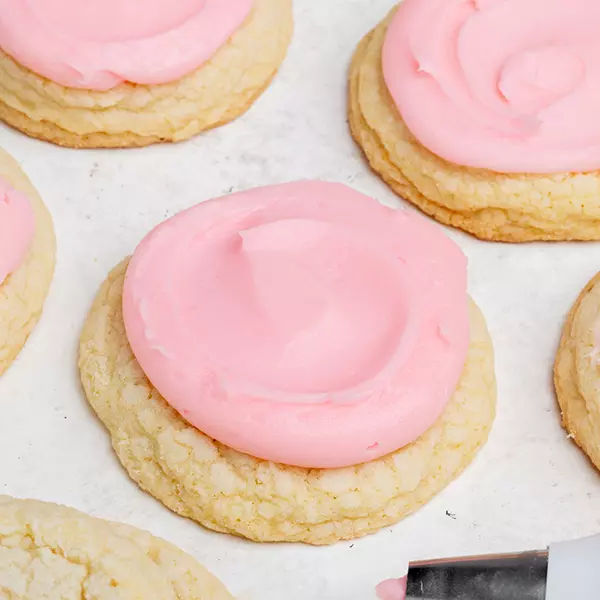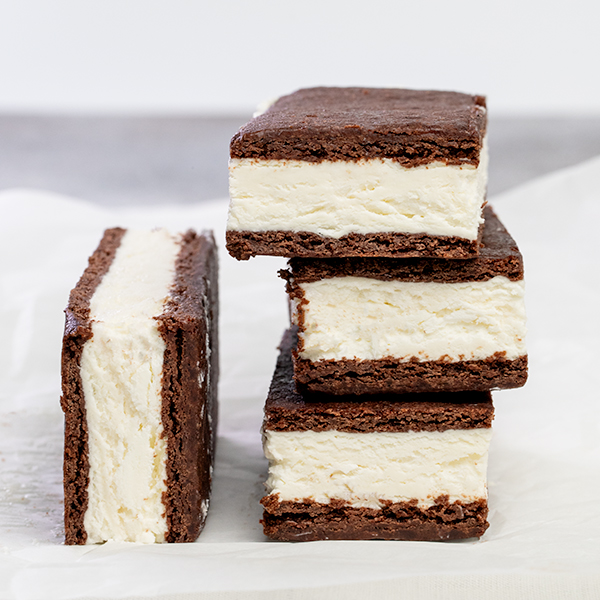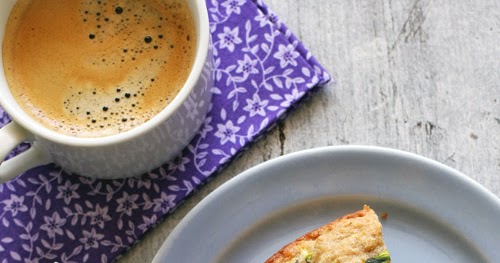If you wish they made Crumble cookies gluten free, this copycat recipe for the thick sugar cookies with the fancy pink frosting is for you. They’re chewy, tender, and piled with rich vanilla almond frosting.

My gluten free Crumbl Cookies copycat recipe will satisfy you when you’re craving a simple bakery-style cookie and can’t just walk into the store to buy one. They’re are a delightful copy of Crumbl Cookies, but safe for a gluten free diet.
Whether you’re a seasoned baker or a beginner, this easy-to-follow recipe will guide you to create a batch of soft, chewy, and irresistibly sweet cookies that everyone can enjoy.

Why you’ll love to make Crumbl cookies gluten free
These gluten free cookies are incredibly easy to make. The copycat gluten free version of this recipe is straightforward and simple, since you don’t need any fancy equipment or obscure ingredients—just a few pantry staples and a little bit of time.
They do taste just like the original, except I have been told that they’re better. That may only be because Crumbl doesn’t even seem to make their pink sugar cookies any more and people miss them! Despite being gluten free, these cookies maintain the same irresistible taste and texture that made you fall in love with Crumbl cookies in the first place.
They’re soft, chewy, and perfectly sweet, with a bakery richness in the cookie, and a delightful hint of almond in the thick, buttery, sweet frosting. They’re about 2 ounces each, so they’re more like the smaller size Crumbl cookies that they never seem to have available in stores.
To make these cookies seem even more authentic, as if Crumbl were in any way allergy friendly, double the amount of cookie dough in each mound. Use a #8 spring-loaded ice cream scoop and make each cookie 4 ounces. You’ll need to increase the baking time at 300°F until the cookies do not glisten in the center at all.

Cookie ingredient notes
Since there aren’t very many ingredients in these cookies, each major ingredient must be selected, measured and treated properly for the cookies to taste and look this much like the original Crumbl sugar cookie. They are:
- GF Flour: You must use one of my recommended all purpose gluten free flour blends, or this recipe will not have the right texture or shape at all.
- Baking soda helps the cookies to brown in the oven; salt brightens all the flavors.
- Granulated sugar: There isn’t more or less sugar than would be expected in a cookie of this type, since they are sugar cookies. Sugar is a sweetener a tenderizer, and helps the cookie brown lightly in the oven.
- Butter: The butter in these cookies should be at cool room temperature, meaning that it should look smooth, not greasy, and a light touch with your finger should make an impression but shouldn’t go all the way to the center. Unsalted butter is used to control the amount of salt in the recipe, and the amount of moisture since salted butter has around 15% more moisture than unsalted.
- Egg: A single egg, yolk and white, binds the cookie dough together, gives it lift in the oven, and some richness.
- Flavoring: I used LorAnn brand butter emulsion oil, sometimes called butter vanilla emulsion or butter bakery emulsion. It adds true depth and richness to the cookies. You can leave it out, though, and replace it with twice as much pure vanilla extract.
How to make famous Crumbl sugar cookies gluten free
Some of the details about making the cookies are most for appearances, like tinting the frosting pink, swirling it just so, and making the cookies perfect in size and shape. But the rest of the details, like the temperature of the butter, how much to beat it, and measuring your gf flour precisely by weight, are essential.

- First, whisk the dry ingredients of all purpose gluten free flour with xanthan gum, baking soda, and salt until uniformly combined.
- Then, beat the butter until smooth and creamy but not too airy.
- Add the granulated sugar and beat well, making a somewhat grainy mixture.

- To the butter and sugar mixture, add the egg and butter emulsion, and beat until smooth and somewhat fluffy. Don’t overbeat.
- Add the dry ingredients you whisked together, and beat until smooth. The dough should be thick and not greasy or overly sticky.
- This dough remains at room temperature, so we proceed to scooping the dough into large mounds, each about 2 ounces in weight. Don’t disturb the mounds at all!
- Bake the cookies first at 350°F to give the cookies some height, then reduce the temperature a ton to finish baking without browning too much.

How to make the Crumbl cookie frosting
Crumbl cookies are famous for their swirly frostings that are piled high on their cookies with their trademark swirl. The frosting is a basic buttercream that is balanced perfectly to be smooth and spreadable, but thick enough to hold its shape and even set enough to stack the cookies lightly on top of one another.
We begin with the same cool room temperature butter. If you’d like to be really precise, you can check with an instant read thermometer and it should be around 65°F. You’ll beat it until it’s smooth, and then add some cream and flavorings. Crumbl’s pink frosting is legendary for having some almond flavoring, but you can replace that with vanilla if you’d prefer.
How to frost a Crumbl cookie
I like to shape the frosting on these cookies using a spoon or offset spatula that’s I’ve moistened slightly with warm water. That makes the frosting easily spreadable while keeping it thick, creates a smooth finish, and helps the frosting to set enough to stack the cookies lightly on one another after they rest.
Begin with about 2 tablespoons of frosting on top of each cookie. Mound the frosting in the very center of the cookie, then use that slightly moistened spoon or offset spatula to press the frosting out toward the edge of the cookie in a mostly even layer.
Starting about 1/8 inch from the edge of the cookie, press a clean, moist offset spatula into the frosting about 1/8 inch deep all around the edge while rotating the cookie. Finish with a slight swirl toward the center.

Tips for perfect cookies every time
Making perfect Crumbl cookies gluten free isn’t just about following the recipe—it’s about understanding how to prepare the ingredients and the importance of each step of the process.
A recipe is a formula, and I can’t promise results if you don’t follow the formula, including ingredient selection, handling, and preparation. Here are some tips to help you achieve cookie perfection every time you bake.
Cool room temperature butter
One of the key steps in making these cookies (and the frosting!) is ensuring your butter is at cool room temperature before you start. This might seem like a small detail, but it’s crucial for achieving the right texture.
Room temperature butter blends more easily with the sugar, creating a smooth and creamy base for your cookies. If the butter is too cold, it won’t blend properly, and if it’s too warm and greasy, the dough won’t hold its shape and it won’t puff up in the oven.
If you forgot to take your butter out of the fridge about an hour before you start baking, try pouring very hot water into a bowl, dumping the water out, and placing the hot bowl over your butter. It also helps to chop the butter into chunks and leave it exposed to the air in the warmest part of your kitchen.

Watch your baking temperature and time
You must be careful not to overbake your cookies, but they must begin baking at a higher temperature (350°F), then lowered to 300°F and allowed to finish baking. Your oven temperature will fall steadily for the remaining baking time, resulting in the perfect height, texture, and flat top.
Overbaked cookies can become hard and dry, while perfectly baked ones will be soft, chewy, and absolutely delicious. If you would prefer, you can bake your cookies at 300°F for about 20 to 22 minutes, and they will be pale even on the bottom, and much wider and flatter.
Quality gluten free flour
A really good gluten free flour blend is critical for any gluten free baking recipe. Some blends can result in a gritty texture or an off-putting aftertaste, and won’t combine properly with other ingredients to provide good results at all. Others are simply poorly balanced, and can’t be used as described in this recipe.
Coconut flour, almond flour, or any other flour that isn’t a rice-based blend will not work in this recipe. They would require their own, distinct recipe for even a basic sugar cookie.

Crumbl Cookie FAQs
According to my taste testers, it’s hard to tell the difference. These gluten-free Crumbl Cookies are just as soft, chewy, and delicious as the original. They have that same irresistible sweetness and texture. You might even forget they’re gluten-free.
Unfrosted cookies can be stored at room temperature, covered well, for about 2 days. Store them, wrapped tightly in a freezer-safe wrap or bag in the freezer for up to 5 months.
The frosted cookies can be covered and stored in the refrigerator for 3 days, or frozen in a single layer on a baking sheet and piled gently into a freezer-safe plastic bag for longer storage (up to 3 months if sealed tightly).
You can try to make these cookies dairy-free by using a vegan butter substitute, and a plant-based milk.
My favorite dairy free butter substitute brands are Miyoko’s Kitchen and Melt. Earth Balance buttery sticks have too much moisture, so I would avoid using that as a substitute.
For the frosting, you can try using half vegan butter and half vegetable shortening.
You may be able to use 50 grams of aquafaba in place of the single egg.
I’ve made these cookies with two egg whites in place of the egg, and the recipe works well
If you use 2 egg whites or aquafaba in place of the egg, I recommend flattening the center of each scoop of dough before baking so the cookies are level once baked.
The short answer is no, the original Crumbl Cookies are not gluten-free. They all contain what flour and some also have other gluten-containing ingredients, including barley malt. So they contain comparatively large amounts of gluten and are not safe if you’re gluten-sensitive
No, salted butter typically has 15% more moisture than unsalted butter, which makes the cookie dough too wet and the cookies spread too much. Plus, salted butter sometimes has much more salt, sometimes much less salt than intended.
You may not have baked them at a high temperature to start, which creates some early lift on the sides of the cookie that ensures the thickness. Or your butter may have been too soft and perhaps even greasy.
Butter emulsion is a flavored oil that adds extra buttery richness to baked goods. You can replace it with more vanilla extract, and forget the whole butter emulsion thing!
You might be able to add some a few ounces of chocolate chips to this recipe, but they won’t really taste like the Crumbl chocolate chip cookies.
If your butter has become greasy, I’m afraid there’s no way to bring it back to cool room temperature and have it still beat nice and fluffy. Maybe melt the butter all the way and use it to make a double batch of our gluten free chocolate chip muffins. Or add some more butter and make a gluten free apple crisp.

Gluten Free Crumbl Cookies
If you wish they made Crumble cookies gluten free, this copycat recipe for the thick sugar cookies with the fancy pink frosting is for you. They’re chewy, tender, and piled with rich vanilla almond frosting.
Yield: 8 cookies
Prevent your screen from going dark
Ingredients
For the cookies
- 1 ½ cups (210 g) all purpose gluten free flour blend please click thru for appropriate blends
- ⅜ teaspoon xanthan gum (omit if your blend already contains it)
- ½ teaspoon baking soda
- ¼ teaspoon kosher salt
- 8 tablespoons (112 g) unsalted butter at cool room temperature (not greasy)
- 1 cup (200 g) granulated sugar
- 1 (50 g (weighed out of shell)) egg at room temperature
- ½ teaspoon butter vanilla emulsion or twice as much pure vanilla extract
For the frosting
- 8 tablespoons (140 g) unsalted butter at cool room temperature (not greasy, but not firm)
- 2 tablespoons (2 fluid ounces) heavy cream at room temperature
- ½ teaspoon pure vanilla extract
- ½ teaspoon pure almond extract optional (can be replaced with more vanilla)
- ¼ teaspoon kosher salt
- 2 ½ cups (460 g) confectioners’ sugar plus more as needed
- 1 drop neon pink gel food coloring optional
Instructions
Make the cookies.
-
In a separate medium-size bowl, place the flour blend, xanthan gum, baking soda, and salt, and whisk to combine well. Set the dry ingredients aside.
-
Preheat your oven to 350°F. Line rimmed baking sheets with unbleached parchment paper and set them aside.
-
In a large bowl with a handheld mixer, or the bowl of a stand mixer fitted with the paddle attachment, place the butter and beat on medium-high speed for about 3 minutes, or until creamy and smooth.
-
Add the granulated sugar, and beat until fully combined, and light but not overly fluffy.
-
Add the egg and butter emulsion or vanilla extract, and beat until fully combined and smooth.
-
Add the dry ingredients to the butter and sugar mixture, and beat on medium speed until just combined.
-
The dough will be thick and smooth, but easy to shape and should not be greasy.
-
Using a large spring-loaded ice cream scoop or two spoons, scoop mounds of cookie dough about 3 tablespoons each (about 2 ounces), and place them about 2-inches apart on the prepared baking sheets. Do not flatten or disturb the mounds.
-
Place the baking sheet in the center of the preheated oven and bake for 5 minutes. Reduce the oven temperature to 300°F and bake until no longer shiny in the center (about 12 minutes ).
-
Remove from the oven and allow to cool on the baking sheet for at least 10 minutes, or until stable, before transferring to a wire rack to cool completely.
-
The cookies will deflate a bit as they cool, which will give you that uneven, slightly crackled texture that we are looking for.
Make the frosting.
-
In the bowl of your stand mixer fitted with the paddle attachment or a large bowl with a hand mixer, beat the butter on medium speed until smooth but not airy (about 2 minutes).
-
Add the heavy cream, almond extract, vanilla extract, and salt.
-
Increase the mixer speed to high and beat until creamy, about another 3 minutes.
-
Add about 2 cups of the confectioners’ sugar. Beat slowly until the sugar is incorporated.
-
Turn the mixer up to high and beat until the frosting becomes uniformly thick (about another 3 minutes).
-
Scoop some of the frosting with a spoon or offset spatula and attempt to place it back and swirl it a bit.
-
Add as much of the rest of the confectioners’ sugar as necessary to thicken the frosting to a thick, but spreadable, swirlable consistency.
-
Add the optional gel food coloring, and beat slowly, and then faster until you reach medium speed. Beat until fully incorporated but try not to incorporate air bubbles into the frosting.
Frost the cookies
-
Once the cookies are completely cool, place a generous dollop of about 2 tablespoons on top of each cookie with a spoon, offset spatula, or pastry bag with large open piping tip.
-
Mound the frosting in the very center of the cookie, then use a slightly moistened spoon or offset spatula to press the frosting out toward the edge of the cookie in a mostly even layer. (See Recipe Notes)
-
Starting about 1/8 inch from the edge of the cookie, press a clean, slightly moistened spoon or offset spatula into the frosting about 1/8 inch deep all around the edge while rotating the cookie. Finish with a slight swirl toward the center.
-
Allow the cookies to set for about an hour before serving. Let them sit out overnight, uncovered but frosted, and you'll be able to stack them gently.
Storage
-
Unfrosted cookies can be stored at room temperature, covered well, for about 2 days. Store them, wrapped tightly in a freezer-safe wrap or bag in the freezer for up to 5 months.
-
The frosted cookies can be covered and stored in the refrigerator for 3 days, or frozen in a single layer on a baking sheet and piled gently into a freezer-safe plastic bag for longer storage (up to 3 months if sealed tightly).
Notes
If you feel any pressure at all to frost the cookie just so, please allow me to release you of it!
Just spoon the frosting on top in the center and smush it to the edges as best you can. Moistening the spoon or spatula helps make the frosting a bit more spreadable, allows for a more even finish, and helps the frosting set up firmer.
Gluten Free Crumbl Cookies
If you wish they made Crumble cookies gluten free, this copycat recipe for the thick sugar cookies with the fancy pink frosting is for you. They're chewy, tender, and piled with rich vanilla almond frosting.
Yield: 8 cookies
Prevent your screen from going dark
Ingredients
For the cookies
- 1 ½ cups (210 g) all purpose gluten free flour blend please click thru for appropriate blends
- ⅜ teaspoon xanthan gum (omit if your blend already contains it)
- ½ teaspoon baking soda
- ¼ teaspoon kosher salt
- 8 tablespoons (112 g) unsalted butter at cool room temperature (not greasy)
- 1 cup (200 g) granulated sugar
- 1 (50 g (weighed out of shell)) egg at room temperature
- ½ teaspoon butter vanilla emulsion or twice as much pure vanilla extract
For the frosting
- 8 tablespoons (140 g) unsalted butter at cool room temperature (not greasy, but not firm)
- 2 tablespoons (2 fluid ounces) heavy cream at room temperature
- ½ teaspoon pure vanilla extract
- ½ teaspoon pure almond extract optional (can be replaced with more vanilla)
- ¼ teaspoon kosher salt
- 2 ½ cups (460 g) confectioners’ sugar plus more as needed
- 1 drop neon pink gel food coloring optional
Instructions
Make the cookies.
-
In a separate medium-size bowl, place the flour blend, xanthan gum, baking soda, and salt, and whisk to combine well. Set the dry ingredients aside.
-
Preheat your oven to 350°F. Line rimmed baking sheets with unbleached parchment paper and set them aside.
-
In a large bowl with a handheld mixer, or the bowl of a stand mixer fitted with the paddle attachment, place the butter and beat on medium-high speed for about 3 minutes, or until creamy and smooth.
-
Add the granulated sugar, and beat until fully combined, and light but not overly fluffy.
-
Add the egg and butter emulsion or vanilla extract, and beat until fully combined and smooth.
-
Add the dry ingredients to the butter and sugar mixture, and beat on medium speed until just combined.
-
The dough will be thick and smooth, but easy to shape and should not be greasy.
-
Using a large spring-loaded ice cream scoop or two spoons, scoop mounds of cookie dough about 3 tablespoons each (about 2 ounces), and place them about 2-inches apart on the prepared baking sheets. Do not flatten or disturb the mounds.
-
Place the baking sheet in the center of the preheated oven and bake for 5 minutes. Reduce the oven temperature to 300°F and bake until no longer shiny in the center (about 12 minutes ).
-
Remove from the oven and allow to cool on the baking sheet for at least 10 minutes, or until stable, before transferring to a wire rack to cool completely.
-
The cookies will deflate a bit as they cool, which will give you that uneven, slightly crackled texture that we are looking for.
Make the frosting.
-
In the bowl of your stand mixer fitted with the paddle attachment or a large bowl with a hand mixer, beat the butter on medium speed until smooth but not airy (about 2 minutes).
-
Add the heavy cream, almond extract, vanilla extract, and salt.
-
Increase the mixer speed to high and beat until creamy, about another 3 minutes.
-
Add about 2 cups of the confectioners’ sugar. Beat slowly until the sugar is incorporated.
-
Turn the mixer up to high and beat until the frosting becomes uniformly thick (about another 3 minutes).
-
Scoop some of the frosting with a spoon or offset spatula and attempt to place it back and swirl it a bit.
-
Add as much of the rest of the confectioners’ sugar as necessary to thicken the frosting to a thick, but spreadable, swirlable consistency.
-
Add the optional gel food coloring, and beat slowly, and then faster until you reach medium speed. Beat until fully incorporated but try not to incorporate air bubbles into the frosting.
Frost the cookies
-
Once the cookies are completely cool, place a generous dollop of about 2 tablespoons on top of each cookie with a spoon, offset spatula, or pastry bag with large open piping tip.
-
Mound the frosting in the very center of the cookie, then use a slightly moistened spoon or offset spatula to press the frosting out toward the edge of the cookie in a mostly even layer. (See Recipe Notes)
-
Starting about 1/8 inch from the edge of the cookie, press a clean, slightly moistened spoon or offset spatula into the frosting about 1/8 inch deep all around the edge while rotating the cookie. Finish with a slight swirl toward the center.
-
Allow the cookies to set for about an hour before serving. Let them sit out overnight, uncovered but frosted, and you'll be able to stack them gently.
Storage
-
Unfrosted cookies can be stored at room temperature, covered well, for about 2 days. Store them, wrapped tightly in a freezer-safe wrap or bag in the freezer for up to 5 months.
-
The frosted cookies can be covered and stored in the refrigerator for 3 days, or frozen in a single layer on a baking sheet and piled gently into a freezer-safe plastic bag for longer storage (up to 3 months if sealed tightly).
Notes
If you feel any pressure at all to frost the cookie just so, please allow me to release you of it!
Just spoon the frosting on top in the center and smush it to the edges as best you can. Moistening the spoon or spatula helps make the frosting a bit more spreadable, allows for a more even finish, and helps the frosting set up firmer.



